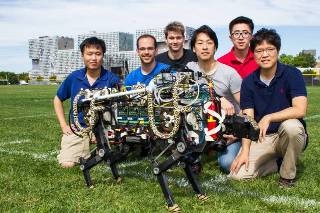Sep 19 2014
Researchers at MIT have developed a new bounding algorithm, which enabled a cheetah robot to sprint across grass. During indoor tests it reached a speed of 10mph and on the Killian Court it bounded at a steady clip. This robot is expected to reach a speed of 30mph.
 MIT cheetah-bot experiment in Briggs Field. (From left) Sehyuk Yim, Joao Luiz Almeida Souza Ramos, Wyatt L Ubellacker, Sangbae Kim, Xu Sun, and Hae Won Park.Photo: Jose-Luis Olivares/MIT
MIT cheetah-bot experiment in Briggs Field. (From left) Sehyuk Yim, Joao Luiz Almeida Souza Ramos, Wyatt L Ubellacker, Sangbae Kim, Xu Sun, and Hae Won Park.Photo: Jose-Luis Olivares/MIT
The cheetah robot developed at MIT, consists of electric motors, batteries and gears, and has weight equivalent to that of a cheetah. The Vitesse Professor of Electrical Engineering at MIT, Jeffrey Lang, designed a novel high-torque-density electric motor that provides the dynamics for the robot. MIT principal research engineer, David Otten, designed the amplifiers for controlling the motor.
The researchers adopted a force-control approach that is similar to methods used by world-class sprinters. For maintaining the desired speed, each robotic leg had to be programmed to apply a specific amount of force at the exact time that it hit the ground.
When a faster speed was required, then more force had to be exerted on the ground. An MIT associate professor of mechanical engineering, Sangbae Kim, states that control of the force profile for the specific short time period and the following hit on the ground, provides stability and dynamism to the robot.
In biomechanics, the percentage of time that a leg stays on the ground is termed as “duty cycle.” The newly developed algorithm determines the force that had to be exerted by each leg in the specific short period of the duty cycle that it hits the ground. This force should be sufficient for the robot to overcome the downward gravitational force and also move forward.
The bounding algorithm provided accurate control for the robot over the forces that it had to exert during running. This algorithm is to be presented at the IEEE/RSJ International Conference on Intelligent Robots and Systems.